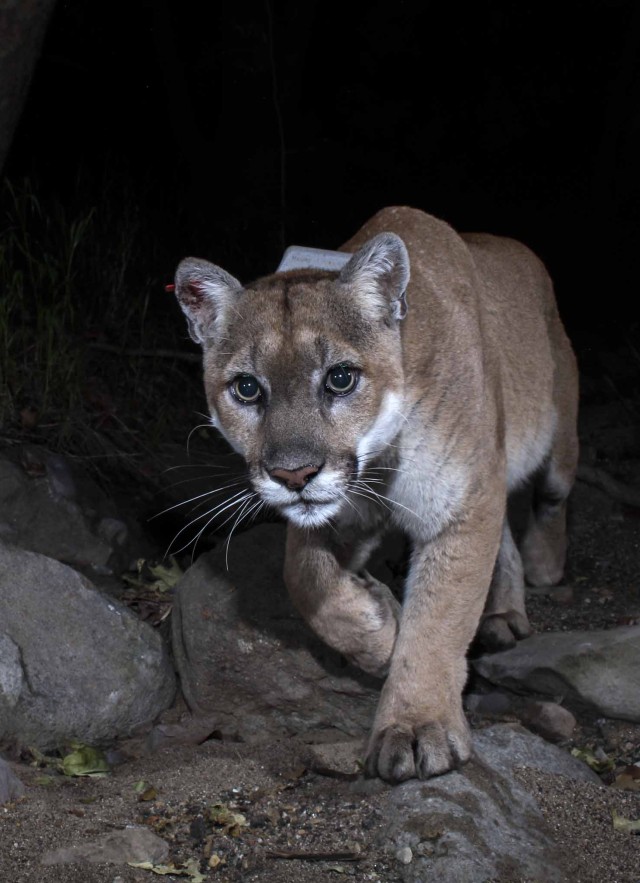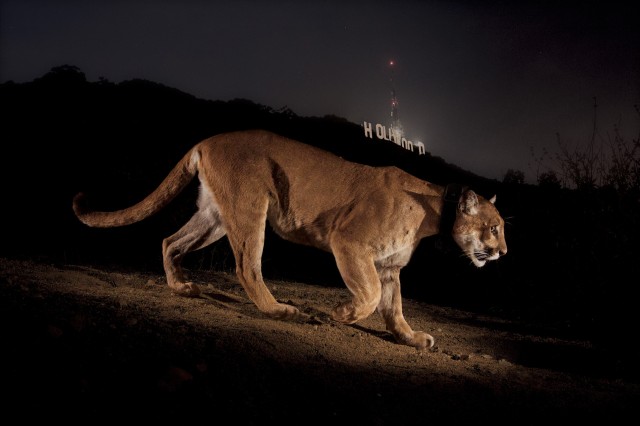Los Angeles, CA (December 17, 2022) — The Natural History Museums of Los Angeles County (NHMLAC) is sharing the following statement by Miguel Ordeñana, Senior Manager of Community Science, on the passing of P-22, Los Angeles’ famous and beloved mountain lion that lived in Griffith Park:
“On behalf of everyone at NHMLAC, we are very saddened by the loss of P-22, an iconic ambassador for wildlife in Los Angeles. His passing is a painful moment, but we are so thankful for how he created a better understanding of the coexistence of urban wildlife, humans and L.A.’s biodiversity. His story is a catalyst for change, inspiring conservation efforts, including the 101 freeway wildlife crossing and much more. Even in his death, P-22 continues to inspire L.A. to embrace urban wildlife conservation and the nature that surrounds us. NHMLAC will continue to share his story, and honor and preserve his legacy for generations to come.”
Ordeñana hopes P-22’s legacy will provide all communities, including those historically excluded from nature, with a sense of pride and belonging in LA nature and within the field of wildlife conservation.
The California Department of Fish and Wildlife (CDFW), along with wildlife biologists with the National Park Service made the decision to euthanize P-22 this morning due to the severity of the injuries he suffered after being hit by a car. He was captured and tranquilized earlier this week out of concern for his well-being due to his advanced age, declining health, and recent attacks on pets in residential areas, which suggested the puma was in distress. After being examined by the CDFW, it was determined that he was malnourished, suffering from mange, and had extreme trauma to one eye, possibly from contact with a motor vehicle.
The CDFW confirmed this morning that P-22’s final resting place will be at the Natural History Museum in Exposition Park in order to further research efforts on mountain lion biology and conservation. Specific plans are still being determined.
P-22 was first spotted in 2012 by Ordeñana as part of the Griffith Park Connectivity Study, a joint effort of Friends of Griffith Park, Cooper Ecological Monitoring, Inc. and the U.S. Geological Survey. For the study, Ordeñana had set camera traps (motion-activated cameras) to document wide-ranging wildlife in the park and on potential corridors as a way to document connectivity between Griffith Park and neighboring open spaces. Ordeñana was thrilled to discover an image of a mountain lion, whose presence in the area had previously not been officially verified. Discovering a mountain lion in Griffith Park confirmed for scientists the park’s role as a haven for wildlife that is more connected to nearby open spaces than previously thought.
After his discovery, P-22 was captured by Santa Monica Mountains National Recreation Area biologists to examine and fit him with a tracking collar. P stands for puma, and he is the 22nd in the federal study of local pumas. Genetic testing confirmed that he was born in the western Santa Monica Mountains, and his father was P-01, the first puma to be studied. P-22 later journeyed to Griffith Park by crossing both the 405 and 101 freeways on foot.
Mountain lions can be found across California and are legally classified as a specially-protected species, which is under review to be listed as threatened under the California Endangered Species Act. Threats to their survival in Southern California include habitat loss and fragmentation due to urban development and wildfires. This can reduce connectivity between populations, limiting genetic diversity. Mountain lions can also be harmed by ingesting rat poison or being struck by a vehicle.
P-22 lived as a solitary mountain lion in Griffith Park surviving mainly on mule deer, in addition to coyotes and raccoons, typical prey of Southern California mountain lions. Images of P-22 in iconic L.A. locations and on neighborhood security cameras made the puma a public figure and unofficial city mascot. P-22 also inspired a movement to create a wildlife crossing over the 101 freeway. The construction of the Wallis Annenberg Wildlife Crossing began in April 2022 and is expected to be completed in 2025. It will be one of the largest such corridors in the United States.
In 2017, NHM debuted The Story of P-22, L.A.’s Most Famous Feline, a permanent exhibit that documents P-22’s journey through graphics, projections, photography, and video, including footage of the puma being collared and moving through his territory at night. The exhibit also explores survival challenges that he and all of Southern California’s mountain lions face living in L.A.’s backyard; visitors can see the locations of tracked mountain lions in real-time as well as markers for those that have perished.
NHM will continue to honor P-22’s legacy through the exhibition, which it plans to update and upgrade in the coming year, with added stories, programs, and more. In addition, and with the support of the National Wildlife Federation, NHM recently debuted a P-22 marionette that allows our performing artist team to further bring his story to life through performances that will continue to inspire and engage people of all ages.
Available for interviews:
Miguel Ordeñana, Senior Manager of Community Science
Dr. Kayce Bell, Assistant Curator, Mammalogy
Dr. Greg Pauly, Curator, Herpetology/Director, Urban Nature Research Center
About the Natural History Museums of Los Angeles County
The Natural History Museums of Los Angeles County (NHMLAC) include the Natural History Museum in Exposition Park, La Brea Tar Pits in Hancock Park, and the William S. Hart Museum in Newhall. They operate under the collective vision to inspire wonder, discovery, and responsibility for our natural and cultural worlds. The museums hold one of the world’s most extensive and valuable collections of natural and cultural history—more than 35 million objects. Using these collections for groundbreaking scientific and historical research, the museums also incorporate them into on- and offsite nature and culture exploration in L.A. neighborhoods, and a slate of community science programs—creating indoor-outdoor visitor experiences that explore the past, present, and future. Visit NHMLAC.ORG for adventure, education, and entertainment opportunities.

